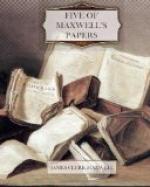of the cone. The lower extremity has a point
of hard steel, which rests in an agate cup, and forms
the support of the instrument. An iron nut,
three ounces in weight, is made to screw on the axis,
and to be fixed at any point; and in the wooden ring
are screwed four bolts, of three ounces, working horizontally,
and four bolts, of one ounce, working vertically.
On the upper part of the axis is placed a disc of
card, on which are drawn four concentric rings.
Each ring is divided into four quadrants, which are
coloured red, yellow, green, and blue. The spaces
between the rings are white. When the top is
in motion, it is easy to see in which quadrant the
instantaneous axis is at any moment and the distance
between it and the axis of the instrument; and we
observe,—1st. That the instantaneous
axis travels in a closed curve, and returns to its
original position in the body. 2ndly. That by
working the vertical bolts, we can make the axis of
the instrument the centre of this closed curve.
It will then be one of the principal axes of inertia.
3rdly. That, by working the nut on the axis, we
can make the order of colours either red, yellow,
green, blue, or the reverse. When the order
of colours is in the same direction as the rotation,
it indicates that the axis of the instrument is that
of greatest moment of inertia. 4thly. That if
we screw the two pairs of opposite horizontal bolts
to different distances from the axis, the path of the
instantaneous pole will no longer be equidistant from
the axis, but will describe an ellipse, whose longer
axis is in the direction of the mean axis of the instrument.
5thly. That if we now make one of the two horizontal
axes less and the other greater than the vertical axis,
the instantaneous pole will separate from the axis
of the instrument, and the axis will incline more
and more till the spinning can no longer go on, on
account of the obliquity. It is easy to see that,
by attending to the laws of motion, we may produce
any of the above effects at pleasure, and illustrate
many different propositions by means of the same instrument.
* Transactions of the Royal Scottish Society of Arts, 1855.
*** Address to the Mathematical and Physical Sections of the British Association.
James Clerk Maxwell
[From the British Association Report, Vol. XL.]
[Liverpool, September 15, 1870.]
At several of the recent Meetings of the British Association the varied and important business of the Mathematical and Physical Section has been introduced by an Address, the subject of which has been left to the selection of the President for the time being. The perplexing duty of choosing a subject has not, however, fallen to me.




